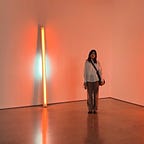Billie Eilish Taught Me How To Build Better Original Products
This was originally posted in February 2020 on LinkedIn
This past year, my sister introduced me to Billie Eilish’s music.
“Leah, you have to check out Billie Eilish’s music… She’s only 17 and recorded her entire album in her brother’s bedroom.”
Since then, Billie became my Spotify 2019 Wrapped artist of year where I streamed 5,296 minutes of her music. Later, I found my mom jamming out to “Bad Guy” while driving to work and my dad intrigued after hearing “Ocean Eyes” playing on our family’s Alexa asking in awe, “Who is the singer? Billie Eyelash?”
Billie was nominated for six Grammy categories and secured five wins, including album of the year, song of the year and best new artist. Not only did she become the youngest person to win one of the Grammy’s top awards at the age of 18. She is the first artist to sweep all four major categories since Christopher Cross did in 1981.
Now the world knows who Billie Eilish is — and she’s no longer my family’s little secret.
What I learned about building original products
Now to the “why” of this article: how did Billie Eilish teach me how to build better original products? I started to ask myself how my family of four, with varying and sometimes conflicting music taste, could agree on one artist to play during dinner. I decided to dig deeper on the success of Billie and why she represents a new era for artists.
Through online research, I quickly found Billie as a walking example of the book Originals: How Non-Conformists Move the World by Adam Grant. Billie encapsulates the theme that originality is rejecting the default and exploring whether a better option exists. But more specifically, I found Billie practicing IDEO’s Design Kit Mindsets which is a philosophy behind Human-centered design, creative problem solving, and how to think about design that directly affects whether you’ll arrive at an innovative or impactful solution.
What we can learn from Billie Eilish
Mindset #1: Creative Confidence
“Creative confidence is the notion that you have big ideas, and that you have the ability to act on them.”
Billie shares in Apple’s Up Next Documentary, “You don’t have to be in love to write a song about being in love. You don’t have to hate someone to write a song about hating someone. It’s just fun to put yourself in a place where you wouldn’t be otherwise.”
Anyone can approach the world like a designer. Often all it takes to unlock that potential as a dynamic problem solver is creative confidence. Creative confidence is the belief that everyone is creative, and that creativity isn’t the capacity to draw or compose or sculpt, but a way of approaching the world.
Creative confidence is the quality that human-centered designers rely on when it comes to making leaps, trusting their intuition, and chasing solutions that they haven’t totally figured out yet. It’s the belief that you can and will come up with creative solutions to big problems and the confidence that all it takes is rolling up your sleeves and diving in. Learn more
Mindset #2: Make It
“You’re taking risk out of the process by making something simple first. And you always learn lessons from it.”
FINNEAS shares his humble family abode where he and his sister Billie have written and produced all of their music so far. FINNEAS describes producing or creating music as, “immediacy”. He continues, “The way I want any home studio to function: as fast as I can think of an idea, I want to be able to articulate it. I recorded me and Billie standing in the bathroom and striking these matches. She recorded the entire vocal of the album on my bed with her legs crossed.”
Human-centered designers are doers, tinkerers, crafters, and builders. We have a bias toward action, and that means getting ideas out of our heads and into the hands of the people we’re looking to serve. We make using anything at our disposal, from cardboard and scissors to sophisticated digital tools. In the end, it doesn’t matter what you use, or how beautiful the result is, the goal is always to convey an idea, share it, and learn how to make it better. Learn more
Mindset #3: Embrace Ambiguity
“We may not know what that answer is, but we know that we have to give ourselves permission to explore.”
At the launch of Billie’s WHEN WE ALL FALL ASLEEP, WHERE DO WE GO? debut album and Immersive Album Experience she shares, “I really wanted the album to be cohesive with itself, but I also wanted everything to be unique on its own and be completely different. The contrast of having 14 songs that sound completely different but all make sense with each other and become one body of work. I’m most proud of that.” With the Immersive Album Experience she brought her entire track list to life incorporating sight, hearing, taste, smell, and touch.
Human-centered designers always start from the place of not knowing the answer to the problem they’re looking to solve. And though that’s not particularly comfortable, it allows us to open up creatively, to pursue lots of different ideas, and to arrive at unexpected solutions. By embracing that ambiguity, and by trusting that the human-centered design process will guide us toward an innovative answer, we actually give ourselves permission to be fantastically creative. Learn more
Alexa play *Billie Eilish* on Spotify
As we approach the products we build or dream to build, we can all channel our inner “Billie Eilish” and be reminded of the mindsets we can grow, learn or act upon. It’s time to set our world on fire with the ideas we can bring to life.
